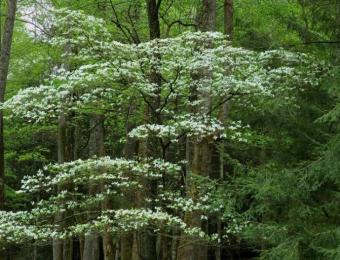
Cornus florida is a deciduous understory tree native to North America. Also known as flowering dogwood, it's loved by gardeners for its early flowering, its graceful shape, and its fall foliage color. And, because it produces small red fruits in the fall, wildlife (especially songbirds) love it as well.
Cornus Florida, AKA Flowering Dogwood

The flowers of Cornus florida can be white, pink or yellow. They often bloom in early spring before the leaves appear. After blooming, small fruits appear, starting out green and then turning a bright red by late summer to early fall. Depending on the variety of flowering dogwood you're growing, the fall foliage is usually either red or bronze in color.
Cornus florida is hardy in Zones 5 through 9.
How to Grow Cornus Florida

Since its native habitat is in the dappled shade of larger trees, it is not surprising that flowering dogwood prefers to be grown in partial shade. It grows taller in shade, up to forty feet, and has a more open and graceful growth habit.
Cornus florida will be smaller, perhaps only as tall as fifteen feet, when grown in full sun, although it may flower more heavily. Its spread is usually slightly greater than its height. This tree is a slow to moderate grower, but it may grow more quickly in shade.
Uses for Flowering Dogwood
Flowering dogwood is recommended for use in screens, as a border accent, or as a specimen. They look wonderful anchoring a garden bed, surrounded by smaller shrubs, annuals, and perennials.
Flowering Dogwood Varieties to Grow

There are so many varieties of cornus florida, and each of them is worth growing for their beauty alone. Add to that the fact that they give both spring and fall color, and you'll definitely want to consider adding one to your garden.
- 'Apple Blossom' has light pink flowers.
- 'Autumn Gold' has white flowers, yellow fall foliage, and vibrant, orangeish twigs.
- 'Bay Beauty' has lush, double, white flowers.
- 'Golden Nugget' has delicate white flowers and green and bronzy-yellow foliage.
- 'Hohman's Gold' produces white flowers and has variegated green and yellow summer foliage and spectacular, deep red fall foliage.
- 'Ozark Spring' blooms with plenty of small white flowers and grows up to about six feet tall.
- 'Purple Glory' has dramatic, dark red flowers, along with maroon to purple summer foliage and dark purple fall foliage.
- 'Royal Red' produces large, deep red flowers. Its new leaves are a vibrant blood red while the deep red fall foliage is reminiscent of a rich red wine.
- 'Stokes Pink' produces delicate pink flowers and medium-green foliage.
- 'Sweetwater Red' has red flowers, reddish summer foliage, and red-purple fall foliage. If you're really a fan of red in the garden, this is the flowering dogwood for you!
Cornus Florida Pests and Problems
Cornus florida is susceptible to many diseases and pests. Good air circulation helps to prevent disease.
- The dogwood borer will attack newly planted specimens, trees in poor health and those damaged by impact (usually from lawn mowers or weed trimmers). Provide mulch beneath the tree to reduce mechanical damage as well as to keep the soil moist, but do not put the mulch directly against the tree's trunk.
- Other problem insects include borers, scale, and leaf miner.
- Crown canker, powdery mildew and leaf-spotting fungi will also attack flowering dogwood.
- Dogwood anthracnose (Discula destructiva), a fungal disease, has killed many flowering dogwoods. If you garden in an area where the fungus is known to be present, consider planting Kousa or Pacific dogwood instead.
A Perfect Flowering Tree for Your Garden
Cornus florida is one of those trees that can just elevate the whole look of your garden with its delicate blooms and graceful form. And since it's a North American native, it also provides food for wildlife, including cardinals, juncos, northern flickers, American robins, cedar waxwings, and other North American songbirds.







